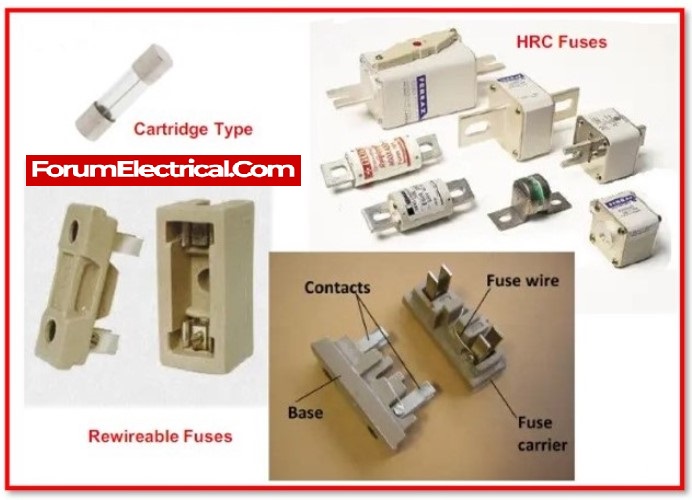What is a fuse?

Fuse protects electrical devices from overloads and short circuits. It interrupts electrical circuits under short circuit or overload currents.
It protects against overloads and short circuits upto 66 KV and 400 kV. Their use is limited to applications where their performance features are suitable for the current interruption.
The fuse works due to current heating. The fuse conducts normal current. Due to normal current, the fuse element generates heat, which the surrounding air dissipates. Thus, the fuse’s temperature remains below the melting point.

Short circuit current flows via the fuse element during a fault. Compared to normal current, the current is large. Fuse elements heat up from short circuit current. Thus, the element melts. Short circuit or overload current is prevented by the fuse.
The fuse element is built of a premium metal conductor. The cartridge holds the fuse. The element’s fuse allows normal current to flow through it and breaks the circuit when high magnitude current goes through it.
Advantages of Fuse
- The utilization of fuses is the most cost-effective kind of protection.
- The element of the fuse can be changed quite easily.
- The fuse does not require any sort of maintenance.
- In a situation where there is a short circuit, it has the effect of limiting the current.
- When compared to circuit breakers, its functioning is entirely automatic, it takes significantly less time, and there is no complication involved in any part of it.
- The large percentage of fuses have their own built-in safety mechanisms, which include the capability to blow out electrical arcs.
- When utilize fuses with elements of smaller sizes, it can limit the amount of current that flows through the circuit in the event of a short circuit.
- Because of the properties of its inverse time-current correlation, it can be used as overload protection.
- Fuse has the ability to interrupt extremely large short circuits without causing any noise, flame, or smoke to be produced.
- Simple to remove and replace without causing any damage by coming into contact with a component that is still active.
- The time it takes for a fuse to do its operation can be considerably less than the time it takes for a circuit breaker to do its function. It serves as the principal protection against electrical short circuits.
- It takes a minimal period of time, which is measured in milliseconds (or 0.002 seconds), to break the circuit when there is a failure.
- When compared to other switchgear protection equipment, it has a smaller area, making it simpler to transfer and operate than its alternatives.
- Performs the function of a barrier between the human body and the electric circuit.
- Prevents device failure due to incorrect circuit operation.
- Damage from inappropriately connected loads is prevented.
Disadvantages of Fuse

- It is not built to handle overload, and if it happens, replacing the fuse can be a time-consuming process. During this time there was a power outage.
- The protection provided by the fuse cannot be reliable.
- A low capacity for breaking.
- In comparison to circuit breakers, fuses are quite slow. It is at a very slow speed.
- A circuit breaker can be reset and utilised several times, whereas replacing a fuse following an operation requires a considerable amount of time.
- In the event that a motor is started, it is unable to withstand a surge current.
- The circuit was not protected against an under-voltage by the fuse.
- Because the elements of the fuse that are responsible for fusing are exposed to air, the fuse will eventually become oxidised.
- Because of this, the element’s resistance is increased, which results in the production of heat as a result of the current flowing through it.
- There is a possibility that the fuse wire may be replaced if it were of the inappropriate size.
- It is not always possible to establish a correlation between the current time features of a fuse and those of the protective device.
- When fuses are connected in series, it is difficult to discriminate against the fuse unless the fuse has a considerable size difference. This is the case even when the fuse has a significant size difference.
- Since the fuse does not react to the high voltage and is only concerned with the flow of current, it is highly unlikely that it will melt and prevent the house from being destroyed in the event that it is struck directly by lightning.
- It is hard to achieve accurate calibration of the fuse wire because a longer fuse will activate earlier than one of a shorter length.
- It is not recommended to use fuse in circuits that have a high voltage rating.
In the primary distribution system, fuses are utilised for the purpose of providing protection to transformers with ratings that do not exceed 200 KVA and the cables that are part of light and power circuits that operate at low voltages. In applications with low or moderate voltage, where it is not expected that the device would be operated frequently or where the use of a circuit breaker would be uneconomical, fuses are used instead of circuit breakers.









